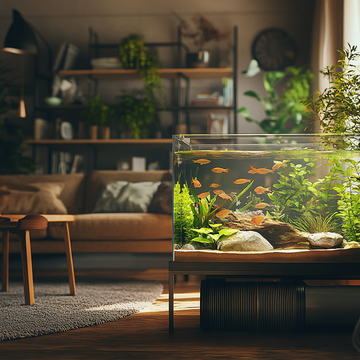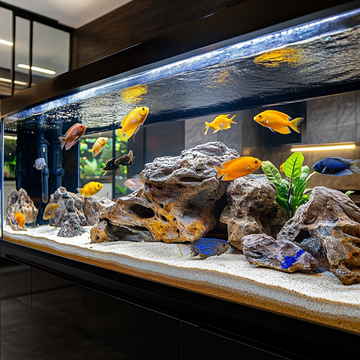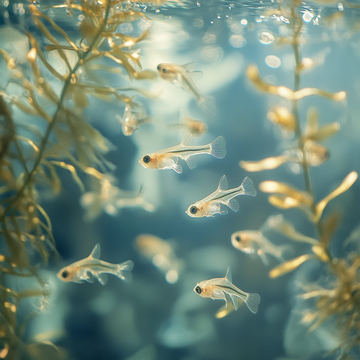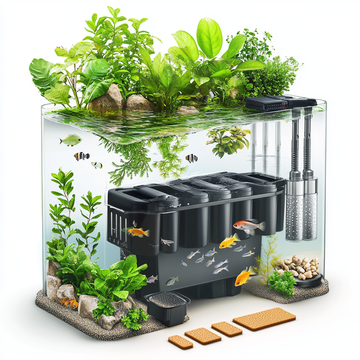At G.Valkyria, we know that your aquarium is more than just decoration; it is a living ecosystem that deserves the best care 🏞️💙. Maintaining a healthy and thriving aquarium requires understanding the importance of proper filtration. Mechanical, chemical, and biological filtration systems are essential to maintaining water quality and ensuring the well-being of your fish and aquatic plants 🌿. In this article, we will explore in depth each type of filtration, its function, and how to achieve them through specific filter materials and equipment. Join us on this journey to a crystal-clear, life-filled aquarium! 🌟
What is Aquarium Filtration and Why is it Important? 🧐
Aquarium filtration is the process by which waste and harmful substances are removed from the water, maintaining a clean and healthy environment for the aquarium inhabitants. The three main types of filtration are:
- Mechanical Filtration : Removes physical particles and solid waste.
- Chemical Filtration : Removes dissolved substances and chemical compounds.
- Biological Filtration : Converts toxic compounds into less harmful ones using beneficial bacteria.
Each type of filtration plays a crucial role in water quality , preventing disease and promoting a balanced ecosystem 🐟🌿.
1. Mechanical Filtration 🧽
What is it?
Mechanical filtration is the process of removing physical particles and solid waste from water, such as food scraps, dead plants, and fish waste.
Why is it Important?
- Water Clarity : Keeps water visually clean and clear.
- Ammonia Prevention : Reduces the decomposition of organic matter that releases ammonia.
- Biological Filtration Protection : Prevents debris from clogging biological media.
How is it achieved?
-
Mechanical Filter Materials :
- Filter Sponges : Capture larger particles.
- Perlón or Synthetic Fiber : Traps fine particles.
- Basket Filters : With layers of different densities.
Equipment Used :
- Internal Filters : They contain sponges or filter cartridges.
- Hang-On-Back Filters : Include compartments for mechanical media.
- Canister Filters (External) : Allows you to customize the filter materials.
G.Valkyria Tip : Clean mechanical materials regularly to maintain their efficiency. Avoid using chlorinated water that can damage beneficial bacteria 🌊.
2. Chemical Filtration 🧪
What is it?
Chemical filtration uses special materials to remove dissolved substances and harmful chemical compounds from water, such as heavy metals, chlorine and drug residues.
Why is it Important?
- Toxic Removal : Removes substances that may be harmful to fish and plants.
- Odor and Color Control : Eliminates tannins and other compounds that color water.
- Parameter Adjustment : Helps maintain the chemical balance of water.
How is it achieved?
-
Chemical Filter Materials :
- Activated Carbon : Absorbs organic and chemical impurities.
- Ion Exchange Resins : Eliminate nitrates, phosphates and heavy metals.
- Zeolite : Absorbs ammonia and nitrogen compounds.
Equipment Used :
- Internal and External Filters : With compartments for chemical media.
- Media Reactors : For more efficient chemical filtration in advanced aquariums.
G.Valkyria Tip : Regularly change chemicals as recommended by the manufacturer to maintain their effectiveness 🗓️.
3. Biological Filtration 🦠
What is it?
Biological filtration is the process by which beneficial bacteria convert toxic substances, such as ammonia and nitrites, into less harmful nitrates through the nitrogen cycle .
Why is it Important?
- Water Detoxification : Eliminates toxic compounds that can be fatal to fish.
- Ecosystem Balance : Maintains a healthy and stable environment.
- Essential for Aquarium Cycling : Establishes the necessary bacterial colony.
How is it achieved?
-
Biological Filter Materials :
- Ceramic Tubes : They offer a large surface area for bacterial growth.
- Bio Balls : Plastic structures with high surface area.
- Fine Pore Sponges : In addition to mechanical filtration, they house bacteria.
Equipment Used :
- Canister and Backpack Filters : With compartments for biological media.
- Sponge Filters : Ideal for small or breeding aquariums.
- Fluidized Bed Filters : For advanced biological filtration.
G.Valkyria Tip : Avoid cleaning biological media with chlorinated water. If necessary, rinse gently with aquarium water to preserve bacteria 👐.
Integrating the Three Types of Filtration in your Aquarium 🧩
A complete filtration system must combine all three types of filtration to ensure an optimal environment:
-
Incorporation into the Filter :
- Use a filter that allows the addition of mechanical, chemical and biological materials.
- Example : A canister filter with separate compartments.
-
Selection of Filter Materials :
- First : Mechanical material to retain large particles.
- Second : Biological material to house bacteria.
- Third : Chemical material to remove dissolved substances.
-
Regular Maintenance :
- Clean and replace filter media as needed.
- Monitor water quality with regular testing.
G.Valkyria Tip : Don't replace all filter media at once to avoid removing too much beneficial bacteria. Make staggered changes 🗓️.
Understanding and properly applying mechanical, chemical, and biological filtration systems is essential to maintaining a healthy and beautiful aquarium 🐠💖. By integrating these three types of filtration, you provide a clean and balanced environment for your fish and aquatic plants. At G.Valkyria, we are committed to your success as an aquarist and offer you high-quality products and expert advice. Transform your aquarium into a thriving ecosystem and enjoy the beauty of the aquatic world in your home! 🌊✨
Share your experience!
Do you have any tips or experiences regarding filtration systems in your aquarium? 🐟💬 Share with us in the comments and let's help other enthusiasts create healthy and successful aquariums!
We hope you find this article helpful! If you have any questions or need personalized advice, please feel free to contact us . At G.Valkyria, we are here for you and your wonderful aquatic pets 🐠💕.







